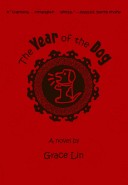 Year of the Dog
Year of the Dog
Written by Grace Lin
Little, Brown & Company, 2005, 124 pp.
ISBN: 9780316060028
Year of the Dog is Grace Lin’s memoir of growing up as a Chinese American whose parents wanted her to fit in with other American youth. To her family, she is known as Pacy, but to her American friends, Grace. Lin tells the story of her struggle to find her identity in a bicultural world. What name should she go by? What should she tell her friends? Pacy/Grace thinks about whether she is Chinese, Taiwanese or American. Her mother tells her to say she is American. The reader learns of the richness behind Pacy’s heritage as Lin skillfully weaves a tapestry of her identity through her mother’s stories of growing up in Taiwan and then immigrating to America.
Strong cultural traditions permeate the family’s lifestyle and readers are treated to the importance of celebrations, food, significance of color, and oral story-telling in Pacy’s life. As the story opens, we sense the family’s excitement at the arrival of Chinese New Year through the hustle and bustle of greetings from Taiwanese relatives, food preparation for the special Chinese New Year dinner, and the tradition of putting out sweet candies. Here, the reader gets a glimpse of Pacy’s attempt to blend East and West as she and her sister fill the tray with sticky taffy melon Chinese candy and M & Ms, to reconcile being both Chinese and American.
Lin’s clever chapter vignettes take readers into Pacy’s world in the Year of the Dog, according to the Chinese calendar. As the family looks forward to the Year of the Dog, Pacy’s Mom explains that it is a good year in Chinese culture for family and friends, but also for thinking and finding herself. Pacy yearns to find her special talent, striving to win at the school Science Fair, Halloween costume contest, and school play. Pacy wants to try out for the part of Dorothy in The Wizard of Oz. Her friend Becky, who is White, explains the impossibility of her being Dorothy because “Dorothy’s not Chinese.” Readers are drawn to the pain in Pacy’s heart, “Like a melting icicle, my dream of being Dorothy fell shattered on the ground. I felt like a dirty puddle after the rain.”
Pacy’s school and home life engage the reader as she continues to struggle in finding herself. She is delighted to find another Chinese American student, Melody, who becomes her new friend. But, even the lunch lady mistakes Pacy for Melody. At Taiwanese American Camp, the Taiwanese and Chinese children make fun of her because she doesn’t speak either language and call her an “Americanized Twinkie”—yellow on the outside, white on the inside. She is appalled that there are no books about real Chinese people, other than The Five Chinese Brothers, in the school library.
The opportunity to reconcile her dual identity and her unique talents emerges when she is encouraged to enter a writing contest about being Chinese American. This was the beginning of Lin’s book, The Ugly Vegetables. As the Year of the Dog draws to a close, Pacy eventually finds ways to appreciate being both Taiwanese and American, but more importantly, an acceptance of not having to be one more than the other.
Year of the Dog is a good book to use as a mentor text for young writers who struggle with coming up with an idea. The richest stories come from real life experiences. The book serves as a model for helping students from diverse backgrounds share their unique traditions and their own treasured cultural stories. Children may also appreciate the addition of their own artwork to use as supportive illustrations, as Lin incorporated her childlike drawings into each chapter.
Year of the Dog presents teachers with an opportunity to enhance their classroom library with a book that speaks to accurate representation, cultural authenticity and appeal to wide audiences. It provides students with an opportunity to discuss lives of people who may be different from them, or on a more significant note, what they share and have in common. Year of the Dog can appeal to many middle grade students of all backgrounds as it deals with childhood concerns of wanting to belong, making friends, and being proud of who you are.
Further, pairing Year of the Dog with selected images from Gene Yang’s graphic novel, American Born Chinese (2006) can be used to highlight racial stereotypes. To help students reconstruct positive images that depict contemporary Chinese Americans, they can create a collage of images downloaded from Google Images, and compare images of real people to the characters and ask students to discuss how these collages refute stereotypes. Helping students to develop sensitivity to stereotyping and raise awareness of inequity works towards building empathy and a more equitable society of compassion and respect for all humanity.
Avis Masuda, University of Hawaii at Hilo, Hilo, HI
WOW Review, Volume II, Issue 3 by Worlds of Words is licensed under a Creative Commons Attribution-NonCommercial-ShareAlike 4.0 International License. Based on work at https://wowlit.org/on-line-publications/review/ii-3/
